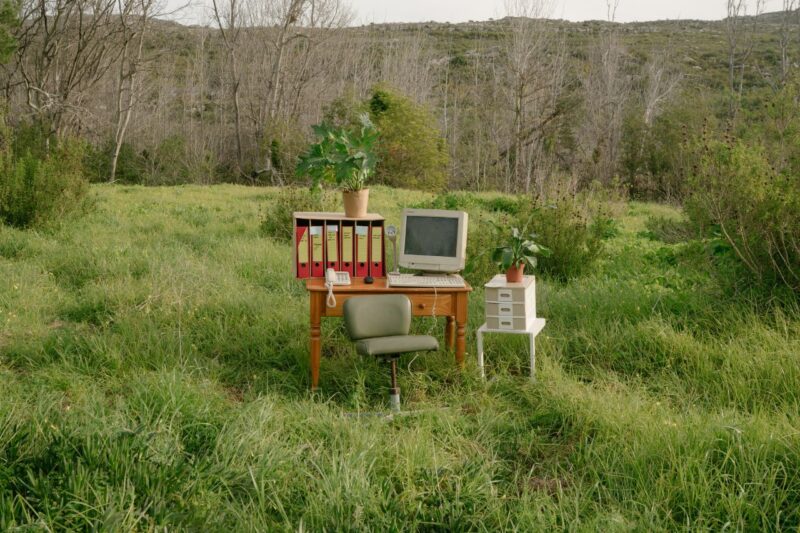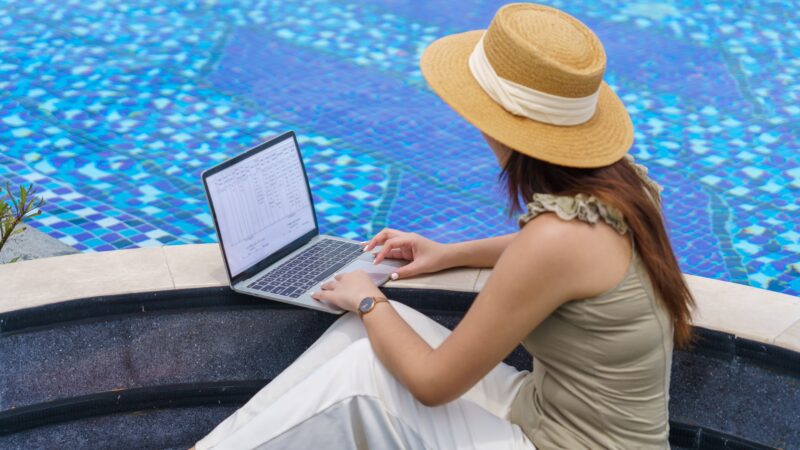Being a Filipino digital nomad might look like all palm trees and airplane selfies on Instagram, but behind the scenes, there’s a lot of planning to ensure I can get work done efficiently – no matter where I am.
Over the years, I’ve hopped between bustling Asian cities and quaint European towns, learning how to adapt my remote office setup each time. From big cities like Cebu and Makati to tropical paradises like Palawan and Siargao, the journey has been an adventure.
Want to master the art of remote work and travel? Check out the eBook “The A-Z on How to Become a Digital Nomad” for expert advice and actionable steps to help you thrive in the digital nomad lifestyle!
If you’re ready to create a productive, flexible, and travel-friendly workspace, here are my go-to tips.

Why Having the Right Remote Office Setup Matters
I quickly realized that consistently producing quality work is tough without a dedicated workspace. When you’re frequently changing locations, it’s easy to get distracted – new sights to see, locals to meet, delicacies to try, and sometimes even noisy neighbors in hostels. You’ll feel you’re one of the tourists even while working. Having a solid remote office setup helps you:
- Stay Focused: A mini work environment keeps your brain in “work mode,” even if you’re in a tiny Airbnb or a crowded café. You’ll also have reliable internet connection that only you can use.
- Maintain Professionalism: Clients and colleagues expect you to handle deadlines and video calls seamlessly. A stable setup means fewer technical hiccups and fewer frantic apologies.
- Boost Health & Well-Being: Ergonomics matter! Sitting hunched over a laptop can lead to neck and back pain – use a neck pillow if necessary. Organizing your space properly reduces stress and keeps you comfortable.
- Keep Things Organized: When you know exactly where your chargers, cables, and files are, you can spend less time searching and more time exploring.
By treating your remote office setup as a priority, you’ll find it easier to juggle both your work responsibilities and the joys of travel.
1. Choose the Right Equipment
a. Laptop or Tablet
My Setup: I rely heavily on my laptop for most of my work (email, video calls, writing), and I made sure to get one with decent RAM (8GB or more) and an SSD for quick boot-ups. Trust me, nothing’s worse than your device lagging in the middle of a client meeting.
- Laptop: Look for a lightweight model if you’re always on the move. Aim for 8+ hours of battery life in case you’re working from a café without many outlets.
- Tablet with Keyboard: If most of your tasks revolve around emails, social media scheduling, or basic writing, a tablet paired with a keyboard case might be enough. It’s super light and easy to stash in a small daypack.
b. Portable Monitor
A portable, lightweight monitor has been a lifesaver when I need more screen real estate – like editing multiple spreadsheets or designing visuals. It folds away neatly into my backpack and can be powered via USB.
Pro Tip: Make sure the monitor’s brightness is adjustable, especially if you’re working in varying light conditions (like sunny co-working spaces one day and dimly lit hotels the next).
c. Accessories
- Noise-Canceling Headphones: Perfect for Zoom calls in noisy hostels or airports.
- Travel-Friendly Mouse: A compact wireless mouse reduces wrist strain compared to using only a trackpad.
- Universal Power Adapter: I’ve learned this the hard way – having one universal adapter with multiple USB ports is a must.
2. Creating a Productive Workspace in Small Accommodations
a. Scout Your Space
When I’m booking accommodations, I try to check photos or reviews to see if there’s a decent table or desk. Sometimes it’s just a tiny corner, but if it has enough room for my laptop, I’m good to go.
If There’s No Desk: Get creative! I’ve used windowsills, the foot of the bed, or even a sturdy chair as a makeshift desk. Stack a couple of pillows if you need a little extra height.
b. Lighting & Ergonomics
I’ve worked in some pretty dim corners, so I pack a small ring light or LED lamp to brighten things up. This also helps with video calls, so clients can see my face clearly.
- Lumbar Support: My back started hurting when I spent months working hunched over tiny café tables. Now, I bring a small, inflatable back cushion or use a rolled-up towel behind my lower back. It makes a world of difference.
c. Noise Management
If you’re bunking with roommates in a hostel, it’s worth investing in good earplugs or noise-canceling headphones. I’ll also schedule important calls during quieter hours or book a private space at a coworking center if needed.

3. Staying Organized on the Move
a. Digital Tools
- Cloud Storage: Whether it’s Google Drive or Dropbox, I keep all my documents in the cloud. This way, if my laptop goes kaput (which I hope never happens), I can still access my files. Having an external drive also helps me feel secured.
- Project Management Apps: Trello and Notion are my absolute must-haves. They help me track tasks, client deadlines, and even travel itineraries all in one place.
b. Packing Cubes & Gadget Organizers
I’ve lost count of how many times a tangled charger in my backpack caused me delays. Now, I keep all my cables, chargers, and smaller electronics in a dedicated gadget organizer. It speeds up packing and ensures I’m never scrambling to find a USB cable at 2 AM.
c. Work “Zones”
One trick I’ve learned is to create small “zones” even in a single room. One side is for work – laptop, notepads, headphones, power bank, travel adapter. The other side is for relaxing – books, flip flops, snacks, neck fan, blanket, footrest, eye mask, maybe a yoga mat. Mentally separating my workspace from my chill space keeps me focused and helps me unwind after hours.
4. Bonus Tips & Tricks
a. Test Your Internet
I always do a quick speed test (using speedtest.net or fast.com) before settling down to work. If the wifi is spotty, I’ll consider using my pocket Wi-Fi or local SIM card as a backup.
b. Join Coworking Spaces (or Give Them a Try)
Coworking spots can be a godsend – reliable Wi-Fi, ergonomic chairs, and plenty of networking opportunities with fellow remote workers. If my Airbnb is too cramped or the Wi-Fi is iffy, I’ll buy a day pass at a local coworking space. It’s a nice change of scenery, too.
c. Mind Your Health
A makeshift office can sometimes encourage a sedentary lifestyle. I make sure to stretch every hour or go for a quick walk after a couple of hours of work. Staying healthy is essential for productivity!
Final Thoughts
Setting up a remote office as a Filipino digital nomad is all about balance: you want efficient, reliable gear but not so much stuff that you feel weighed down by your backpack. Focus on the essentials – a good laptop, headphones, portable power bank, wireless waterproof headset, some organizational tools – and get creative with your workspace.
With proper planning, you’ll also meet visa requirements and ensure long-term stays in affordable cost-of-living destinations like Indonesia, Malaysia, and the Philippines. Whether you’re chasing adventure in El Nido, or exploring Metro Manila, the right preparation ensures seamless work and travel.
Make sure you’ve got access to healthcare, a clean criminal record, and proof of minimum income requirements if needed. Leverage Facebook groups and hubs to find the best places with digital infrastructure.
And finally, by prioritizing a proper remote office setup, you’ll be better equipped to handle work deadlines, maintain your well-being, and fully enjoy the freedoms that come with traveling the world.
Don’t forget to carry your passport as you explore each destination and enjoy the perks of living in a tropical paradise. Safe travels and happy working, kapwa Pinoy nomads!
Disclaimer: These tips are based on my personal experiences; adapt them to fit your own travel and work style.
FAQ
The Telecommuting Act of 2019, otherwise known as Republic Act No. 11165, governs remote work that uses telecommunication and computer technologies in the Philippines. This law highlights fair treatment and data privacy when adopting work-from-home (WFH) arrangements.
Which Is Better, an LLC or an S Corp? An LLC is a business structure where taxes are passed through to the owners. An S corporation is a business tax election in which an established corporation passes taxable income to shareholders. Which is better depends on the circumstances.
E-commerce is a category of business that involves buying and selling products or services online through electronic means, such as websites, mobile apps, or other digital platforms. It can include a wide range of businesses, from small online stores to large retailers and marketplaces.
